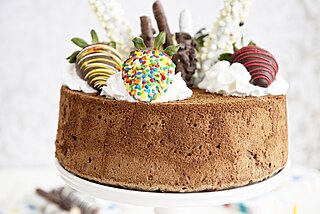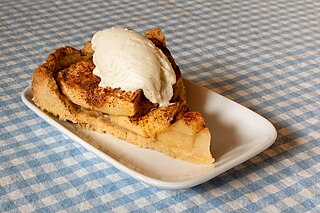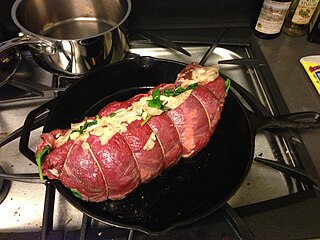
Dessert is a course that concludes a meal. The course consists of sweet foods, such as cake, and possibly a beverage such as dessert wine and liqueur. Some cultures sweeten foods that are more commonly savory to create desserts. In some parts of the world there is no tradition of a dessert course to conclude a meal.

Baking is a method of preparing food that uses dry heat, typically in an oven, but can also be done in hot ashes, or on hot stones. The most common baked item is bread, but many other types of foods can be baked. Heat is gradually transferred "from the surface of cakes, cookies, and pieces of bread to their center. As heat travels through, it transforms batters and doughs into baked goods and more with a firm dry crust and a softer center". Baking can be combined with grilling to produce a hybrid barbecue variant by using both methods simultaneously, or one after the other. Baking is related to barbecuing because the concept of the masonry oven is similar to that of a smoke pit.

Cake is a flour confection made from flour, sugar, and other ingredients and is usually baked. In their oldest forms, cakes were modifications of bread, but cakes now cover a wide range of preparations that can be simple or elaborate and which share features with desserts such as pastries, meringues, custards, and pies.

Costa Rican cuisine is known for being mostly mild, with high reliance on fruits and vegetables. Rice and black beans are a staple of most traditional Costa Rican meals, often served three times a day. Costa Rican fare is nutritionally well rounded, and nearly always cooked from scratch from fresh ingredients. Owing to the location of the country, tropical fruits and vegetables are readily available and included in the local cuisine.

Angel food cake, or angel cake, is a type of sponge cake made with egg whites, flour, and sugar. A whipping agent, such as cream of tartar, is commonly added. It differs from other cakes because it uses no butter. It’s aerated texture comes from whipped egg white. Angel food cake originated in the United States and first became popular in the late 19th century. It gained its unique reputation along with its name due to its light and fluffy texture and white color.

Cookware and bakeware is food preparation equipment, such as cooking pots, pans, baking sheets etc. used in kitchens. Cookware is used on a stove or range cooktop, while bakeware is used in an oven. Some utensils are considered both cookware and bakeware.

Cheesecake is a dessert made with a soft fresh cheese, eggs, and sugar. It may have a crust or base made from crushed cookies, graham crackers, pastry, or sometimes sponge cake. Cheesecake may be baked or unbaked, and is usually refrigerated.

A casserole is a kind of large, deep pan or bowl used for cooking a variety of dishes in the oven; it is also a category of foods cooked in such a vessel. To distinguish the two uses, the pan can be called a "casserole dish" or "casserole pan", whereas the food is simply "a casserole". The same pan is often used both for cooking and for serving.

A cupcake (AmE), fairy cake (BrE), or bun (IrE) is a small cake designed to serve one person, which may be baked in a small thin paper or aluminum cup. As with larger cakes, frosting and other cake decorations such as fruit and candy may be applied.

Apple cakes are cakes in which apples feature as a main flavour and ingredient. Such cakes incorporate apples in a variety of forms, including diced, pureed, or stewed, and can include common additions like raisins, nuts, and 'sweet' spices such as cinnamon or nutmeg. They are a common and popular dessert worldwide, thanks to millennia of apple cultivation in Asia and Europe, and their widespread introduction and propagation throughout the Americas during the Columbian Exchange and colonisation. As a result, apple desserts, including cakes, have a huge number of variations.

A Bundt cake is a cake that is baked in a Bundt pan, shaping it into a distinctive donut shape. The shape is inspired by a traditional European cake known as Gugelhupf, but Bundt cakes are not generally associated with any single recipe. The style of mold in North America was popularized in the 1950s and 1960s, after cookware manufacturer Nordic Ware trademarked the name "Bundt" and began producing Bundt pans from cast aluminum. Publicity from Pillsbury saw the cakes gain widespread popularity.

Boxty is a traditional Irish potato pancake. The dish is mostly associated with the north midlands, north Connacht and southern Ulster, in particular the counties of Leitrim, Mayo, Sligo, Fermanagh, Longford, and Cavan. There are many recipes but all contain finely grated, raw potatoes and all are served fried.

Czech cuisine has both influenced and been influenced by the cuisines of surrounding countries and nations. Many of the cakes and pastries that are popular in Central Europe originated within the Czech lands. Contemporary Czech cuisine is more meat-based than in previous periods; the current abundance of farmable meat has enriched its presence in regional cuisine. Traditionally, meat has been reserved for once-weekly consumption, typically on weekends.

A chiffon cake is a very light cake made with vegetable oil, eggs, sugar, flour, baking powder, and flavorings. Being made with vegetable oil, instead of a traditional solid fat such as butter or shortening, it is easier to beat air into the batter. As a result, chiffon cakes achieve a fluffy texture by having egg whites beaten separately until stiff and then folded into the cake batter before baking. Its aeration properties rely on both the quality of the meringue and the chemical leaveners.

A sheet pan, also referred to as baking tray, baking sheet, or baking pan, is a flat, rectangular metal pan placed in an oven and used for baking pastries such as bread rolls, cookies, sheet cakes, Swiss rolls, and pizzas.

A torte is a rich, usually multilayered, cake that is filled with whipped cream, buttercreams, mousses, jams, or fruit.

A roulade is a dish of filled rolled meat or pastry. Roulade can be savory or sweet. Swiss roll is an example of a sweet roulade. Traditionally found in various European cuisines, the term roulade originates from the French word rouler, meaning "to roll".

Chilean cuisine stems mainly from the combination of traditional Spanish cuisine, Chilean Mapuche culture and local ingredients, with later important influences from other European cuisines, particularly from Germany, the United Kingdom and France. The food tradition and recipes in Chile are notable for the variety of flavours and ingredients, with the country's diverse geography and climate hosting a wide range of agricultural produce, fruits and vegetables. The long coastline and the peoples' relationship with the Pacific Ocean add an immense array of seafood to Chilean cuisine, with the country's waters home to unique species of fish, molluscs, crustaceans and algae, thanks to the oxygen-rich water carried in by the Humboldt Current. Chile is also one of the world's largest producers of wine and many Chilean recipes are enhanced and accompanied by local wines. The confection dulce de leche was invented in Chile and is one of the country's most notable contributions to world cuisine.

Belizean cuisine is an amalgamation of all ethnicities in the nation of Belize and their respectively wide variety of foods. Breakfast often consists of sides of bread, flour tortillas, or fry jacks that are often homemade and eaten with various cheeses. All are often accompanied with refried beans, cheeses, and various forms of eggs, etc. Inclusive is also cereal along with milk, coffee, or tea.
























